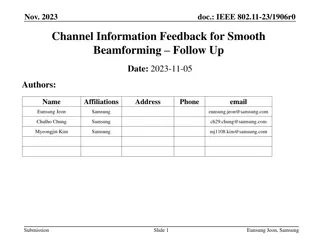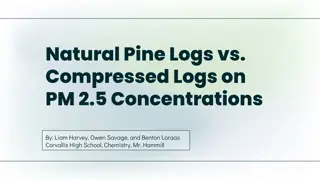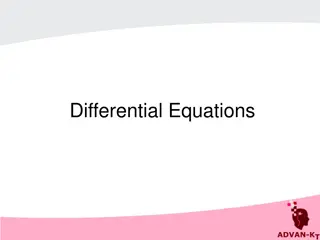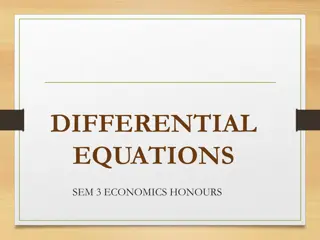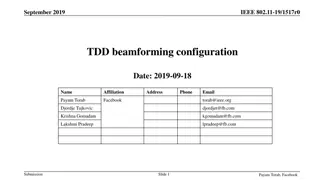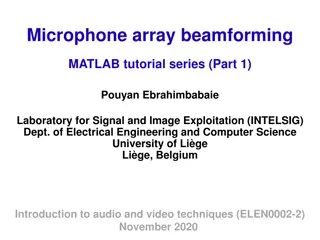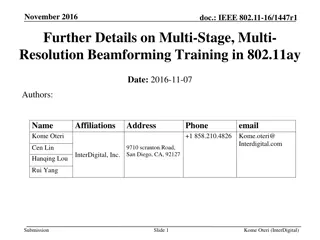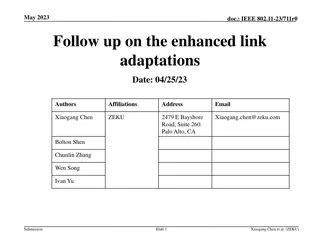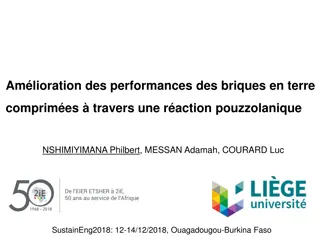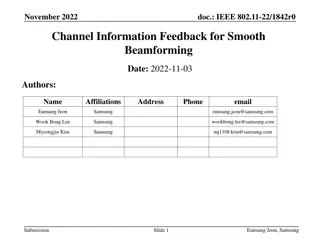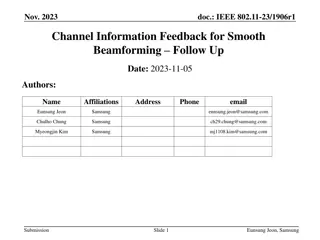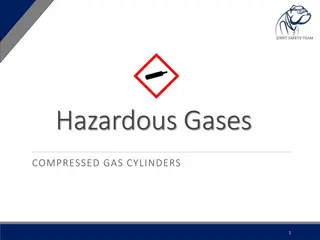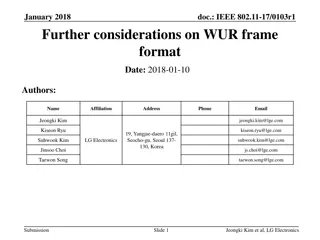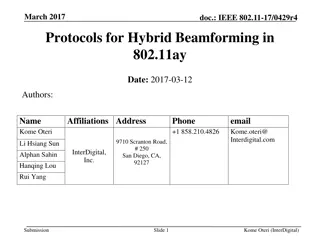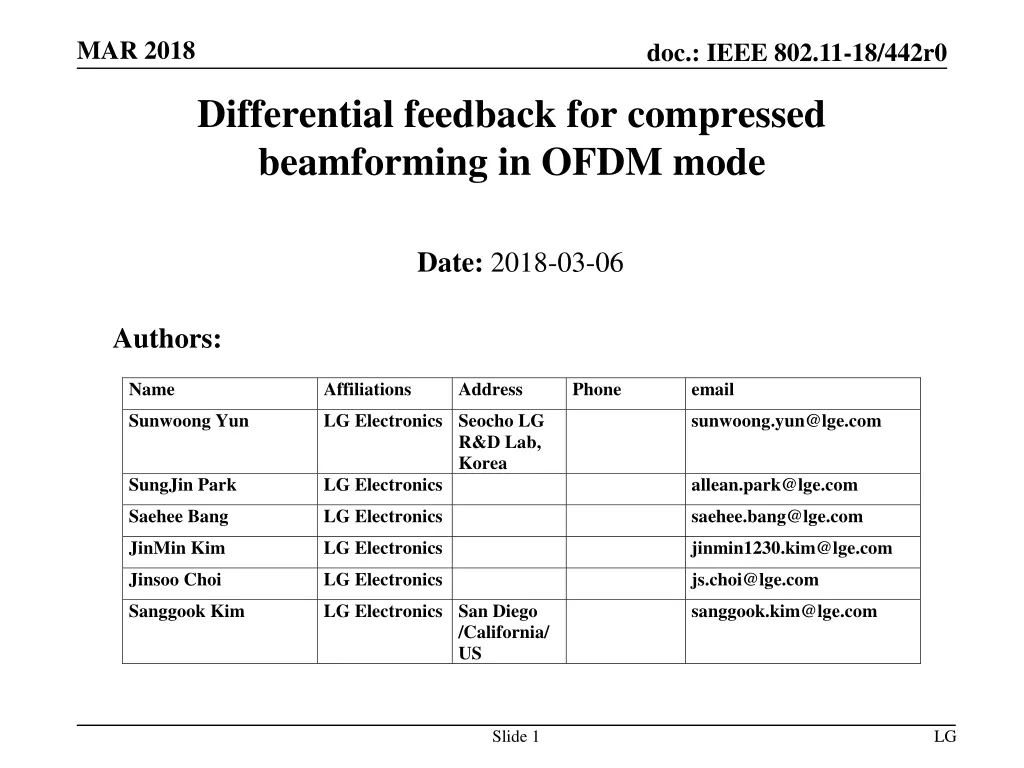
Compressed Beamforming Feedback in OFDM Mode: Differential Feedback Method
Explore the application of compressed beamforming feedback in OFDM mode with differential feedback for improved efficiency. The presentation delves into quantization, feedback bits, observation points on channel selectivity, and a proposed method for differential feedback. Discover innovative solutions in wireless communication technology.
Download Presentation

Please find below an Image/Link to download the presentation.
The content on the website is provided AS IS for your information and personal use only. It may not be sold, licensed, or shared on other websites without obtaining consent from the author. If you encounter any issues during the download, it is possible that the publisher has removed the file from their server.
You are allowed to download the files provided on this website for personal or commercial use, subject to the condition that they are used lawfully. All files are the property of their respective owners.
The content on the website is provided AS IS for your information and personal use only. It may not be sold, licensed, or shared on other websites without obtaining consent from the author.
E N D
Presentation Transcript
MAR 2018 doc.: IEEE 802.11-18/442r0 Differential feedback for compressed beamforming in OFDM mode Date: 2018-03-06 Authors: Name Affiliations Address Phone email Sunwoong Yun LG Electronics Seocho LG sunwoong.yun@lge.com R&D Lab, Korea SungJin Park LG Electronics allean.park@lge.com Saehee Bang LG Electronics saehee.bang@lge.com JinMin Kim LG Electronics jinmin1230.kim@lge.com Jinsoo Choi LG Electronics js.choi@lge.com Sanggook Kim LG Electronics San Diego sanggook.kim@lge.com /California/ US Slide 1 LG
MAR 2018 doc.: IEEE 802.11-18/442r0 Introduction(1/2) In [1], the value of Ng and quantization bits are introduced for OFDM compressed beamforming feedback. Compressed beamforming feedback information (phi and psi) are quantized as follow. ?? ? 2?? radians, where ? = 0,1,2, ,2b 1 2b +2 radians, where ? = 0,1,2, ,2b 1 Phi : = 2?? 1+ k 2b +1+ Psi : = Slide 2 LG
MAR 2018 doc.: IEEE 802.11-18/442r0 Introduction(2/2) In compressed beamforming, feedback bits for each subcarrier are ?? ??+ ??/2 (??:the number of angles, it depends on size of feedback matrix V) 2x2 MIMO Ng=2 NCB=1 NCB=2 NCB=3 NCB=4 Phi (bits) Psi (bits) Total (bits) 1780 3880 5980 8080 178*6 = 1068 388*6 = 2328 598*6 = 3588 808*6 = 4848 178*4 = 712 388*4 = 1552 598*4 = 2392 808*4 = 3232 Required bits for feedback increase as NCB and NSTS increase Slide 3 LG
MAR 2018 doc.: IEEE 802.11-18/442r0 Observation Points(1/2) There exist 11ay CR channels that have relatively lower frequency selectivity as can be seen below For this reason, we investigate quantized phi and psi Slide 4 LG
MAR 2018 doc.: IEEE 802.11-18/442r0 Observation Points(2/2) 1,000,000 channels are used Relative difference : difference of angles between adjacent subcarriers For quantized ?, the portion of more than 90% angles have relative differences within 3 For quantized , the portion of more than 90% angles have relative differences within 1 Slide 5 LG
MAR 2018 doc.: IEEE 802.11-18/442r0 Proposed Method : Differential Feedback(1/2) So, all subcarriers don t need to feedback full bits (?? ??+ ??/2 bits ) This presentation proposes differential feedback for compressed beamforming Differential feedback Feedback relative difference of angles values between nth subcarrier and (n+1)th subcarrier Example) Quantized angles for 1st subcarrier : ?1, ?1(reference subcarrier) Quantized angles for 2nd subcarrier : ?2, ?2 2nd subcarrier report feedback information : ?1- ?2, ?1- ?2 Slide 6 LG
MAR 2018 doc.: IEEE 802.11-18/442r0 Proposed Method : Differential Feedback(2/2) As can be seen previous slide, For quantized ?, the portion of more than 90% angles have relative differences within 3 For quantized , the portion of more than 90% angles have relative differences within 1 We can assign less bits instead of 6,4 for ?, 3bits are sufficient for ? 2bits are sufficient for . Slide 7 LG
MAR 2018 doc.: IEEE 802.11-18/442r0 Overhead reduction Example 2x2 MIMO Ng=2 NCB=1 NCB=2 NCB=3 NCB=4 Conventional (Full feedback) 1780 3880 5980 8080 Proposed (Differential) 890 1940 2990 4040 Reduction 50% We can reduce 50% using differential feedback Moreover, proposed method is more efficient in relatively lower frequency selectivity channel Slide 8 LG
MAR 2018 doc.: IEEE 802.11-18/442r0 Performance analysis In relatively lower frequency selectivity channel, proposed method does not have any performance degradation However, in relatively higher frequency selectivity channel, differential feedback may not be proper So, we define 1 bit to indicate whether full feedback or differential feedback in MIMO Feedback Control Field Receiver can make a decision to apply or not based on channel measurement results Slide 9 LG
MAR 2018 doc.: IEEE 802.11-18/442r0 Conclusion We investigate the characteristic of 11ay channel In relatively lower frequency selectivity channel, we don t need to feedback using full bits We propose optional use of differential feedback for compressed beamforming in relatively lower frequency selectivity channel In our proposed method, we can assign less bits with 50% overhead reduction. Slide 10 LG
MAR 2018 doc.: IEEE 802.11-18/442r0 Straw Poll #1 Do you agree to include the proposed differential feedback method for compressed beamforming in OFDM mode? Slide 11 LG
MAR 2018 doc.: IEEE 802.11-18/442r0 References [1] 11-18-0382-00-00ay-Tone grouping size for hybrid beamforming feedback in OFDM mode Slide 12 LG

